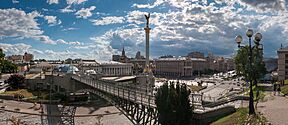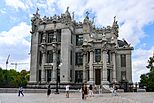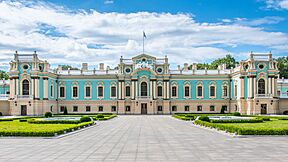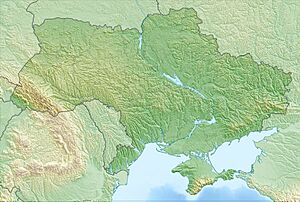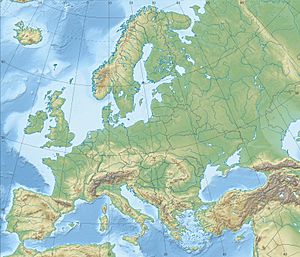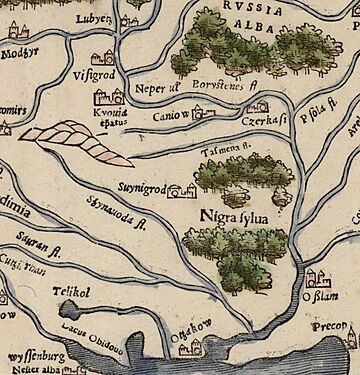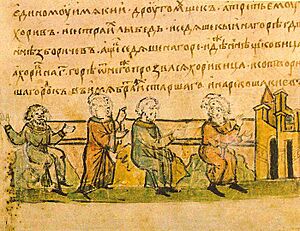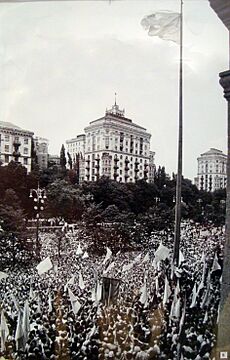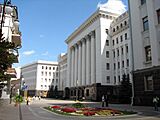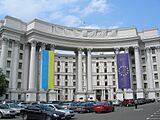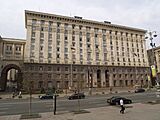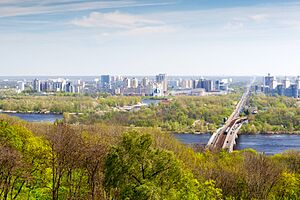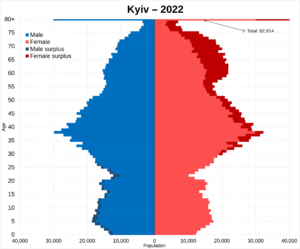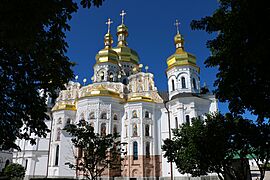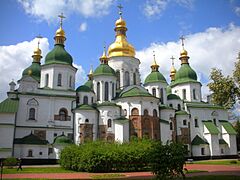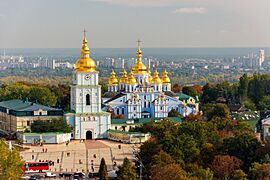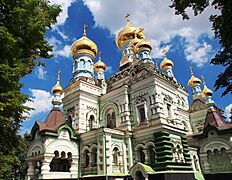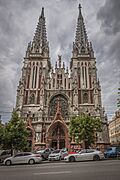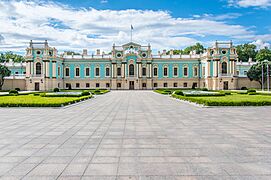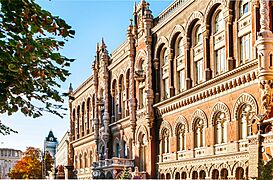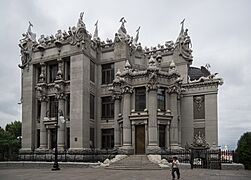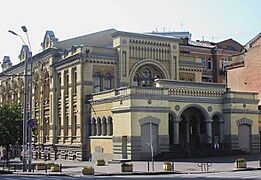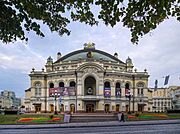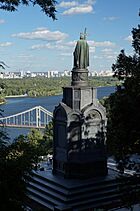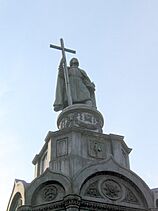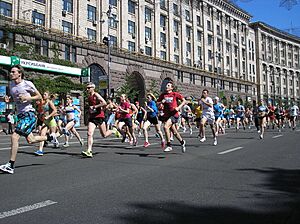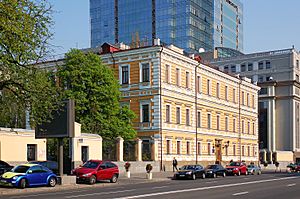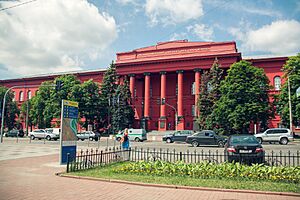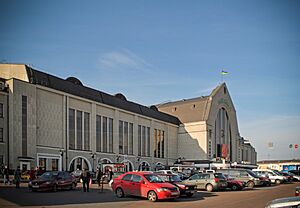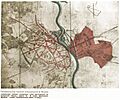Kyiv facts for kids
Quick facts for kids
Kyiv
Київ
Kiev
|
|||||
|---|---|---|---|---|---|
|
Capital city and city
with special status |
|||||
|
Kyiv Pechersk Lavra
Red University Building
House with Chimaeras
Mariinskyi Palace
|
|||||
|
|||||
| Nickname(s):
Mother of Rus' Cities
|
|||||
| Anthem: How Can I Not Love You, Kyiv of Mine! |
|||||
| Country | Ukraine | ||||
| Municipality | Kyiv | ||||
| Founded | AD/CE (officially) 1494 (Magdeburg rights) |
||||
| Named for | Kyi | ||||
| City council | Kyiv City Council | ||||
| Districts |
List of 10
Darnytskyi District
Desnianskyi District Dniprovskyi District Holosiivskyi District Obolonskyi District Pecherskyi District Podilskyi District Shevchenkivskyi District Solomianskyi District Sviatoshynskyi District |
||||
| Area | |||||
| • Capital city and city with special status |
839 km2 (324 sq mi) | ||||
| Elevation | 179 m (587 ft) | ||||
| Population
(1 January 2021)
|
|||||
| • Capital city and city with special status |
|||||
| • Rank | 1st in Ukraine 7th in Europe |
||||
| • Density | 3,299/km2 (8,540/sq mi) | ||||
| • Metro | 3,475,000 of the Kyiv metropolitan area | ||||
| Demonym(s) | Kyivan, Kievan Киянин, Киянка (uk) |
||||
| GDP | |||||
| • Capital city and city with special status | ₴1.28 trillion (US$46.76 billion) (2021) | ||||
| • Per capita | ₴431,616 (US$15,815.9) (2021) | ||||
| Time zone | UTC+02:00 (EET) | ||||
| • Summer (DST) | UTC+03:00 (EEST) | ||||
| Postal code |
01xxx–04xxx
|
||||
| Area code(s) | +380 44 | ||||
| ISO 3166 code | UA-30 | ||||
| Vehicle registration plate | AA, KA (before 2004: КА, КВ, КЕ, КН, КІ, KT) | ||||
| FIPS code | UP12 | ||||
| NUTS statistical regions of Ukraine | UA63 | ||||
Kyiv, also known as Kiev, is the capital and largest city of Ukraine. It is located in the north-central part of the country, on both sides of the Dnieper River. As of January 1, 2022, Kyiv had a population of 2,952,301 people. This makes it the seventh-most populated city in Europe.
Kyiv is a very important place for industry, science, education, and culture. It is home to many high-tech companies, universities, and famous historical sites. The city has a large public transport system, including the Kyiv Metro.
The city's name is believed to come from Kyi, one of its four legendary founders. Kyiv is one of the oldest cities in Eastern Europe. It has gone through many changes, from being a busy trading center in the 5th century to losing much of its power after the Mongol invasion in 1240.
After being part of Lithuania, then Poland, and later the Russian Empire, Kyiv grew into an important center for Orthodox learning in the 16th century. By the 19th century, it became a major hub for industry, trade, and government.
The city thrived during the Industrial Revolution in the Russian Empire in the late 1800s. In 1918, Kyiv became the capital of the Ukrainian People's Republic when Ukraine declared independence. After the Ukrainian-Soviet and Polish-Soviet wars ended in 1921, Kyiv became part of the Ukrainian SSR. It was made the capital of the Ukrainian SSR in 1934.
Kyiv was badly damaged during World War II. However, it quickly recovered and became the third-largest city in the Soviet Union. After the Soviet Union broke apart and Ukraine became independent in 1991, Kyiv remained Ukraine's capital. Many people from other parts of Ukraine moved to Kyiv.
As Ukraine changed to a market economy and democracy, Kyiv continued to be the country's largest and wealthiest city. While its old industries faced challenges, new areas like services and finance helped Kyiv grow. This growth brought higher salaries and more investments. Kyiv has become the most pro-Western part of Ukraine. Political groups that want closer ties with the European Union often win elections here.
Understanding Kyiv's Name
The name Kyiv is the official Ukrainian way to spell the city's name. It is used in laws and official documents. The name Kiev was traditionally used in English. However, because it came from the Russian name, many international news groups stopped using it after the Russo-Ukrainian War began in 2014. This change was part of the KyivNotKiev campaign by Ukraine.
The traditional story says the name comes from Kyi, a legendary founder of the city. Some historians, like Mykhailo Hrushevsky, have questioned this. They think the names of the founders might have come from the place names instead. Another idea is that the name Kyiv comes from an old Slavic word meaning 'stick' or 'pole'. This could mean it was a 'palisaded settlement', a village surrounded by a fence of poles.
A Look at Kyiv's History
Contents |
The first people known to live in the Kyiv area were there during the late Stone Age. During the Bronze Age, the Trypillian culture lived around Kyiv. This is known from artifacts found in the area. In the early Iron Age, tribes settled around Kyiv. They farmed, raised animals, and traded with the Scythians and ancient states near the Black Sea. Roman coins from the 2nd to 4th centuries show that Kyiv traded with the eastern parts of the Roman Empire.
How Kyiv Was Founded
Scholars still discuss when Kyiv was founded. The official founding date is 482 CE, and the city celebrated its 1,500th anniversary in 1982. However, archaeological findings suggest it might have been founded in the 6th or 7th centuries. Some researchers even think it was as late as the end of the 9th century.
There are several legends about how the city began. One popular story from the Primary Chronicle tells of three brothers, Kyi, Shchek, Khoryv, and their sister Lybid. They were part of a Slavic tribe and founded the city. Kyi, the oldest, gave the city its name. Another legend says that Saint Andrew visited the area in the 1st century. He put up a cross where a church was later built. Since the Middle Ages, an image of Saint Michael has been a symbol for the city.
There is not much historical proof from the time the city was founded. Small Slavic settlements existed in the area from the 6th century. However, it is not clear if any of them grew into the city we know today.
The Primary Chronicle says that in the late 9th or early 10th century, Askold and Dir, possibly Vikings, ruled Kyiv. They were killed by Oleg of Novgorod in 882. However, some historians believe that the Khazars ruled Kyiv until the 920s.
Kyiv was located on the important trade route between the Varangians (Vikings) and the Greeks. In 968, the nomadic Pechenegs attacked and surrounded the city. By 1000 CE, Kyiv had a population of 45,000 people.
In March 1169, Grand Prince Andrey Bogolyubsky of Vladimir-Suzdal attacked Kyiv. He left the old town and the prince's hall in ruins. In 1203, Prince Rurik Rostislavich and his allies captured and burned Kyiv. The city was attacked and damaged several times in the 1230s by different Rus' princes. It had not recovered when, in 1240, the Mongol invasion, led by Batu Khan, completely destroyed Kyiv.
These events greatly changed the city's future and the East Slavic civilization. Before Bogolyubsky's attack, Kyiv was known as one of the largest cities in the world. It had over 100,000 people at the start of the 12th century.
In the early 1320s, a Lithuanian army led by Grand Duke Gediminas defeated the Slavic army and took over Kyiv. The Tatars also claimed Kyiv, so the city had to pay tribute to the Golden Horde. In 1362, Algirdas, Grand Duke of Lithuania, made Kyiv part of the Grand Duchy of Lithuania. In 1482, Crimean Tatars attacked and burned much of Kyiv.
With the Union of Lublin in 1569, Kyiv became the capital of the Kyiv Voivodeship within the Polish–Lithuanian Commonwealth.
Under Russian Rule
Russian troops occupied Kyiv in 1654. From 1667, Kyiv became part of the Tsardom of Russia and had some self-rule. In the Russian Empire, Kyiv was a main center for Christianity. It attracted many pilgrims and was home to important religious figures. However, its trade importance was small until the 19th century.

In 1834, the Russian government started Saint Vladimir University. It is now called the Taras Shevchenko National University of Kyiv.
During the 18th and 19th centuries, the Imperial Russian Army and church leaders controlled much of city life. The Russian Orthodox Church was involved in many of Kyiv's buildings and businesses. In the late 1840s, historian Mykola Kostomarov started a secret group called the Brotherhood of Saint Cyril and Methodius. They wanted a federation of free Slavic peoples, with Ukrainians as a separate group. The Russian authorities quickly stopped this group.
Kyiv experienced more Russification in the 19th century. This happened through Russian migration, government actions, and social changes. By the early 20th century, Russian speakers were common in the city center. However, people living on the outskirts kept much of their Ukrainian folk culture. Ukrainian nobles, soldiers, and merchants tried to preserve their native culture in Kyiv. They did this through secret book printing, amateur theater, and folk studies.
During the Russian industrial revolution in the late 1800s, Kyiv became a major trade and transport center. It specialized in sugar and grain export by railway and on the Dnieper river. By 1900, the city was also a big industrial center with 250,000 people. Important developments from this time include railway lines, new schools and cultural places, and famous buildings. In 1892, Kyiv had the first electric tram line in the Russian Empire. Kyiv grew a lot during this time, becoming the third most important city in the Empire.
The Soviet Era
After the 1917 Russian Revolution, Kyiv became the capital of several Ukrainian states. It was caught in many conflicts, including World War I, the Russian Civil War, and the Polish–Soviet War. Kyiv changed hands 16 times between late 1918 and August 1920.
From 1921 to 1991, Kyiv was part of the Ukrainian Soviet Socialist Republic. This republic became a founding member of the Soviet Union in 1922. Major events in Soviet Ukraine affected Kyiv. In the 1920s, Ukrainization and people moving from rural areas made the city more Ukrainian-speaking. This also helped Ukrainian culture grow. Soviet industrialization in the late 1920s turned Kyiv into a major industrial, technology, and science center. The Great Famine of 1932–1933 greatly affected the city's population. Joseph Stalin's Great Purge of 1937–1938 almost wiped out the city's educated people.
In 1934, Kyiv became the capital of Soviet Ukraine. The city grew rapidly during Soviet industrialization. Many large factories were built, and some still exist today.

During World War II, Kyiv was badly damaged again. Nazi Germany occupied it from September 19, 1941, to November 6, 1943. In the 1941 Battle of Kyiv, Axis forces killed or captured over 600,000 Soviet soldiers. Most of those captured did not survive. After the Germans took the city, Soviet officers who had stayed behind blew up most buildings on Khreshchatyk, the main street. These buildings burned for days, leaving 25,000 people homeless.
In response, the Germans gathered nearly 34,000 local Jews and killed them at Babi Yar in Kyiv on September 29 and 30, 1941. In the following months, thousands more people of different backgrounds were killed there. It is thought that over 100,000 people, mostly civilians, were murdered at Babi Yar during World War II.
Kyiv's economy recovered after the war. It became the third most important city in the Soviet Union again. The terrible accident at the Chernobyl Nuclear Power Plant in 1986 happened only 100 km (62 mi) north of the city. However, the wind blew most of the radioactive material away from Kyiv.
Kyiv's Independence Era
As the Soviet Union collapsed, the Ukrainian parliament declared Ukraine's independence in Kyiv on August 24, 1991. In 2004–2005, Kyiv was the site of the largest public protests since the Soviet era, supporting the Orange Revolution. From November 2013 to February 2014, central Kyiv was the main location for Euromaidan, a series of protests.
In February 2022, at the start of the Russian invasion of Ukraine, Russian forces tried to capture Kyiv. However, Ukrainian forces pushed them back from the city's edges. Kyiv itself avoided major damage. After the Russian forces left the region in April 2022, Kyiv has faced frequent air strikes.
Kyiv's Environment and Geography

Kyiv is located where the Polesia woodland zone meets the East European forest steppe biome. The city's unique landscape makes it stand out. Kyiv is completely surrounded by Kyiv Oblast.
Originally, Kyiv was on the west bank of the Dnieper River. Today, it is on both sides of the river, which flows south towards the Black Sea. The older, higher western part of the city is on many wooded hills, with valleys and small rivers. Kyiv's landscape gave names to places like Podil ("lower") and Pechersk ("caves"). Kyiv is part of the larger Dnieper Upland, which adds to the city's changing elevations.
The northern edge of the city borders the Polesian Lowland. Kyiv only expanded onto the left bank of the Dnieper in the 20th century. This area is generally called the Left Bank. Large parts of the left bank Dnieper valley were built up with sand and are protected by dams.
Within the city, the Dnieper River has many branches, islands, and harbors. The city is near where the Desna River meets the Dnieper. It is also close to the Kyiv Reservoir in the north and the Kaniv Reservoir in the south. Both the Dnieper and Desna rivers can be used by boats in Kyiv.
Kyiv has 448 open water bodies, including the Dnieper, its reservoirs, small rivers, lakes, and artificial ponds. These cover 7,949 hectares. The city also has 16 beaches and 35 recreational areas near water. Many are used for fun, but some are not safe for swimming.
According to a 2011 UN report, there were no risks of natural disasters in Kyiv or its surrounding area.
Kyiv's Climate
Kyiv has a warm-summer humid continental climate. The warmest months are June, July, and August, with average temperatures from 13.8 to 24.8 °C (56.8 to 76.6 °F). The coldest months are December, January, and February, with average temperatures from -4.6 to -1.1 °C (23.7 to 30.0 °F). The highest temperature ever recorded was 39.4 °C (102.9 °F) on July 30, 1936.
The coldest temperature ever recorded was -32.9 °C (-27.2 °F) on January 11, 1951. Snow usually covers the ground from mid-November to the end of March. The period without frost lasts about 180 days on average.
Kyiv's Government and Politics
City Government
The city of Kyiv has a special legal status in Ukraine. It is considered a region of Ukraine. This means it has two levels of government control. The Head of the City State Administration, who is the city's governor, is chosen by the president of Ukraine. The Head of the City Council, who is the mayor of Kyiv, is elected by the people of Kyiv.
Vitali Klitschko is the current mayor of Kyiv. He took office on June 5, 2014, after winning the 2014 Kyiv local election with almost 57% of the votes. He was reelected in the 2020 Kyiv local election.
Many important national government buildings are on Hrushevskoho Street and Institute Street. This area is sometimes called the government quarter. The city's main government offices are in the Kyiv City Council building on Khreshchatyk Street.
- Government buildings in Kyiv
-
The seat of the Cabinet of Ministers of Ukraine.
City Politics
Kyiv is the most pro-Western and pro-democracy region in Ukraine. This is due to its growing political and economic importance, and widespread internet use. Political groups that want closer ties with the European Union usually get the most votes in Kyiv elections. A poll in February 2014 showed that only 5.3% of people in Kyiv believed Ukraine and Russia should unite into one state.
City Districts
The Dnieper River naturally divides Kyiv into the Right Bank and Left Bank areas. Historically, the city was on the western right bank. It only expanded to the left bank in the 20th century. Most of Kyiv's famous places and main businesses are on the right bank. The eastern "Left Bank" is mostly residential. Both sides of the river have large industrial and green areas.
Kyiv is also divided into informal neighborhoods. These neighborhoods have populations ranging from about 5,000 to 100,000 people.
The first official division of Kyiv was in 1810. The city was divided into 4 parts. In 1833–1834, Kyiv was divided into 6 police districts, which later increased to 10. During the Soviet era, as the city grew, the number of districts also increased. These districts were often named after important communist figures.
The last district change happened in 2001. The number of districts was reduced from 14 to 10. Each district has its own elected council that handles local matters.
People of Kyiv
According to official records, Kyiv had 2,847,200 residents in July 2013. The population of Kyiv in 2001 was 2,611,327. About 53.3% were female and 46.7% were male. More people with higher education lived in Kyiv in 2001 compared to 1989.
An unofficial estimate in June 2007, based on how many bakery products were sold, suggested that at least 3.5 million people were in the city. This number included visitors and commuters.
Ethnic Groups in Kyiv
Kyiv's population has changed a lot over the centuries. In 1874, about 80% of people in Kyiv spoke Russian, 11% spoke Yiddish, 6% spoke Polish, and 2% spoke German. Of the "Russian" speakers, 39% spoke Ukrainian.
By 1917, Ukrainians made up only 16% of the population, while Russians were the majority at 50%. By 1926, Ukrainians were again the largest group at 41.6%, and Russians were 25.5%. By 1959, Kyiv was mostly Ukrainian, with 60% of the population identifying as such.
According to the 2001 census, over 130 different nationalities and ethnic groups live in Kyiv. Ukrainians are the largest group, making up 82.2% of the population (2,110,800 people). Russians are the second largest group at 13.1% (337,300 people). Other groups include Jews, Belarusians, Poles, and Armenians.
A 2015 study found that 94% of Kyiv's population was ethnic Ukrainian, and 5% was ethnic Russian. Most non-Slavic people in the city are Tatars, people from the Caucasus, and other groups from the former Soviet Union.
Languages Spoken
Both Ukrainian and Russian are commonly spoken in Kyiv. In the 2001 census, about 75% of Kyiv's population said Ukrainian was their native language, and about 25% said Russian. A 2006 survey found that 23% of Kyivans used Ukrainian at home, 52% used Russian, and 24% switched between both.
A 2015 study found that the languages spoken at home in Kyiv were Ukrainian (27%), Russian (32%), and an equal mix of Ukrainian and Russian (40%).
Kyiv's Cityscape
Modern Kyiv is a mix of old and new. About 70% of the buildings built between 1907 and 1914 have been preserved. When Kyiv became the capital of the Ukrainian SSR, many new buildings were added to make it look like a capital city. The city grew quickly from the 1970s to the mid-1990s and has continued to grow since 2000. Because of this, Kyiv's central areas have a mix of new, modern buildings among older apartments.
After Ukraine became independent, many changes happened. Western-style homes, modern nightclubs, fancy restaurants, and nice hotels opened in the city center. With easier visa rules since 2005, Ukraine has become a popular tourist spot. Kyiv, like other big cities, is benefiting from this. The center of Kyiv has been cleaned up, and buildings have been restored, especially Khreshchatyk and Maidan Nezalezhnosti. Many historic areas, like Andriivskyi Descent, are now popular places for street vendors. Here, you can find traditional Ukrainian art, religious items, books, and jewelry.
In 2009, Kyiv was the only city from the Commonwealth of Independent States to be in the TOP30 European Green City Index, ranking 30th.
Kyiv's most famous historical buildings are the St. Sophia Cathedral and the Kyiv Pechersk Lavra (Monastery of the Caves). Both are recognized by UNESCO as World Heritage Sites. Other important historical buildings include the Mariinskyi Palace (built 1745–1752, rebuilt 1870), and several Eastern Orthodox churches like St. Michael's Cathedral, St. Andrew's, and St. Volodymyr's. The reconstructed Golden Gate is also a notable site.
One of Kyiv's well-known modern landmarks is the huge Mother Ukraine statue made of titanium. It stands at the National Museum of the History of Ukraine in the Second World War on the Dnieper's Right Bank. Other famous sites include the cylindrical Salut hotel and the House with Chimaeras.
Some of Kyiv's best-known monuments are the statue of Bohdan Khmelnytsky on his horse near St. Sophia Cathedral. There is also a monument to Vladimir the Great (St. Vladimir), who baptized Rus', overlooking the river from Saint Volodymyr Hill. Another monument honors Kyi, Shchek, Khoryv, and Lybid, the city's legendary founders. On Independence Square, there are two monuments: one of Archangel Michael, Kyiv's historic protector, and another of Berehynia, a modern goddess-protector.
- Architecture and historically significant sites and monuments in Kyiv
Kyiv's Culture
Kyiv was the historic cultural center of the East Slavic civilization. It was also a major place for the Christianization of Kievan Rus. Kyiv kept its cultural importance for centuries. Even during difficult times, it remained a very important center for Eastern Orthodox Christianity. Its holy sites, the Kyiv Pechersk Lavra (Monastery of the Caves) and the Saint Sophia Cathedral, have attracted pilgrims for centuries. They are recognized as UNESCO World Heritage Sites and are major religious centers and tourist attractions. These sites are also part of the Seven Wonders of Ukraine.
In September 2023, the UNESCO World Heritage Committee added the Saint Sophia Cathedral and Kyiv Pechersk Lavra to the List of World Heritage in Danger. This means that while Ukraine is trying to protect them, the war threatens their safety. Being on this list helps get urgent international support.
Kyiv has many theaters, including the Kyiv Opera House, Ivan Franko National Academic Drama Theater, and Lesya Ukrainka National Academic Theater. Other important cultural places are the Dovzhenko Film Studios and the Kyiv Circus. The city has many museums, such as the National Museum of the History of Ukraine and the National Art Museum.
In 2005, Kyiv hosted the 50th annual Eurovision Song Contest. It hosted the contest again in 2017. Many songs and paintings have been made about the city. Some songs became part of Russian, Ukrainian, and Jewish folk traditions. Popular songs include "How not to love you, Kyiv of mine?" and "Kyiv Waltz."
Fun Things to Do in Kyiv
It is said that you can walk across Kyiv in summer without leaving the shade of its many trees. The horse-chestnut trees are very common and a symbol of Kyiv.
Kyiv is known as a green city with two botanical gardens and many parks. The National Museum of the History of Ukraine in the Second World War has indoor and outdoor displays of military history. It is surrounded by green hills overlooking the Dnieper River.
Among Kyiv's many islands, Venetsiiskyi (or Hydropark) is the most developed. You can get there by metro or car. It has an amusement park, beaches, boat rentals, and night clubs. Other major islands include Trukhaniv and Muromets. Victory Park is a popular place for walking, jogging, and cycling. Boating, fishing, and water sports are popular in Kyiv. The lakes and rivers freeze in winter, and you can see ice fishermen and children ice skating. In summer, many people go to the shores for swimming or sunbathing.
The center of Kyiv (Maidan Nezalezhnosti and Khreshchatyk Street) becomes a big outdoor party spot at night during summer. Thousands of people enjoy restaurants, clubs, and outdoor cafes. The main streets are closed to cars on weekends and holidays. Andriivskyi Descent is a famous historic street and a major tourist spot. It has the Castle of Richard the Lionheart, the baroque-style St Andrew's Church, and the home of writer Mikhail Bulgakov.
Many of Kyiv's farmer markets offer a wide variety of fresh produce. The Bessarabskyi Market in the city center is the most famous. Each neighborhood has its own market, or rynok. Here you can find vegetables, fresh meats, fish, cheese, honey, dairy products, flowers, and clothing.
Near the historic Pyrohiv village on the city's southern edge, there is an outdoor museum. It is called the National Museum of Folk Architecture and Folkways of Ukraine. This museum has several "mini-villages" that show traditional rural architecture from different regions of Ukraine.
Kyiv also has many fun places like bowling alleys, go-kart tracks, paintball areas, and billiard halls. The 100-year-old Kyiv Zoo covers 40 hectares and has 2,600 animals from 328 species.
Museums and Art Galleries
Kyiv has about 40 different museums. In 2009, they had a total of 4.3 million visits.
The National Museum of the History of Ukraine in the Second World War is a memorial complex. It remembers the Eastern Front of World War II. It has indoor and outdoor displays of military history and equipment. The Kyiv Fortress includes 19th-century buildings that were once part of a large fortification. Some buildings are now museums, while others are used for military or commercial purposes.
The National Art Museum of Ukraine focuses on Ukrainian art. The Golden Gate is a historic entrance in the old city walls. The name Zoloti Vorota (Golden Gate) is also used for a nearby theater and a metro station. The small Ukrainian National Chernobyl Museum is a memorial and historical center. It is dedicated to the 1986 Chernobyl disaster and its effects on people and the environment.
Sports in Kyiv
Kyiv has many professional and amateur football clubs. These include Dynamo Kyiv, Arsenal Kyiv, and FC Obolon Kyiv. Only Dynamo Kyiv plays in the Ukrainian Premier League. Dynamo Kyiv has been the most successful club in its history. Before the Soviet Union fell in 1991, the club won 13 USSR Championships.
Other important sports clubs in Kyiv include the Sokil Kyiv ice hockey club and BC Budivelnyk basketball club. Both teams play in the top Ukrainian leagues for their sports. Both teams play their home games at the Kyiv Palace of Sports.
During the 1980 Summer Olympics in the Soviet Union, Kyiv hosted football matches at its Olympic Stadium. The stadium was rebuilt for the event. From December 1, 2008, the stadium underwent a major reconstruction to meet UEFA standards for hosting the Euro 2012 football tournament. The opening ceremony was on October 8, 2011. Other notable sports stadiums in Kyiv include the Valeriy Lobanovskyi Dynamo Stadium and the Palace of Sports.
Most Ukrainian national teams play their home international matches in Kyiv. For example, the Ukraine national football team has played matches at the rebuilt Olympic Stadium since 2011.
Tourism in Kyiv
Since Ukraine allowed visa-free travel for EU countries and Switzerland in 2005, more foreign tourists have visited the country. Before the 2008–2009 Ukrainian financial crisis, the number of foreign visits to Kyiv grew by 23% each year for three years. In 2009, 1.6 million tourists stayed in Kyiv hotels. Almost 259,000 (about 16%) of them were foreigners.
After UEFA Euro 2012, Kyiv became a very popular place for European tourists. A record 1.8 million foreign tourists visited, along with about 2.5 million domestic tourists. More than 850,000 foreign tourists visited Kyiv in the first half of 2018. This was more than the 660,000 tourists in the same period in 2013. As of 2018, hotels were about 45–50% full from May to September. Hostels and three-star hotels were almost 90% full.
City Anthem and Symbols
In 2014, Kyiv's city council chose the city's anthem. It is a 1962 song called "Yak tebe ne liubyty, Kyieve mii!" (roughly "How can I not love you, Kyiv of mine!").
The horse chestnut tree is one of Kyiv's symbols. It was featured on the city's coat of arms from 1969 to 1995.
Kyiv's Economy
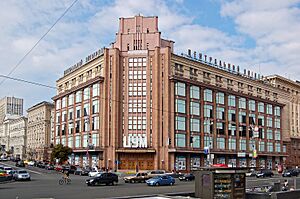
Like most capital cities, Kyiv is a major center for government, culture, and science in Ukraine. It is the largest city in Ukraine by population and area. It also has the highest level of business activity. On January 1, 2010, about 238,000 businesses were registered in Kyiv.
Official numbers show that Kyiv's economy grew faster than the rest of the country's from 2004 to 2008. It grew by an average of 11.5% each year. After the Great Recession, Kyiv's economy faced a big challenge in 2009. Its gross regional product dropped by 13.5%. However, Kyiv's economy, like the rest of Ukraine's, started to recover in 2010 and 2011. Kyiv is a middle-income city, with prices similar to many mid-sized American cities.
Because Kyiv has a large and varied economy, it does not rely on just one industry or company. Its unemployment rate has always been low. Even when joblessness rose to 7.1% in 2009, it was still much lower than the national average of 9.6%.
As of January 2022, the average monthly salary in Kyiv was 21,347 UAH (€540) before taxes.
Kyiv is the main center for business and trade in Ukraine. It is home to the country's largest companies, such as Naftogaz Ukrainy and Kyivstar. In 2010, the city accounted for 18% of national retail sales and 24% of all construction. Real estate is a major part of Kyiv's economy. Apartment prices are the highest in Ukraine and among the highest in Eastern Europe. Kyiv also has Ukraine's tallest office buildings and some of its biggest shopping malls.
In May 2011, Kyiv's government shared a 15-year plan. This plan aimed to attract €82 billion in foreign investment by 2025. The goal was to update the city's transport and utilities and make it more attractive for tourists.
Industries in Kyiv
Major industries in Kyiv include:
- Utilities: electricity, gas, and water supply (26% of total industrial output).
- Food and Beverages: making food, drinks, and tobacco products (22%).
- Chemicals: chemical industry (17%).
- Engineering: mechanical engineering (13%).
- Paper and Printing: making paper products, publishing, and printing (11%).
The Institute of Oil Transportation has its main office here.
Manufacturing Companies
- Kuznia na Rybalskomu: naval production.
- Antonov Serial Production Plant (formerly Aviant): airplanes manufacturing.
- Aeros: small aircraft production.
- Kyiv Roshen Factory: confectionery (sweets).
- Kyiv Arsenal: specializes in making precise optical instruments.
- Obolon: brewery.
- Kyiv Aircraft Repair Plant 410: repair factory at Zhuliany Airport.
Education and Science in Kyiv
Scientific Research
Scientific research happens in many universities and research centers linked to the Ukrainian Academy of Sciences. Kyiv is home to Ukraine's ministry of education and science. It is also known for its work in medical and computer science research.
In 2016, UNIT Factory (Ukrainian National IT Factory) opened. It offers a new way to learn IT. The education is free for students who follow the program rules. This project includes the Technology Companies' Development Center (TCDC) and BIONIC University. It also has two high-tech labs: VR Lab (Crytek) and Smart City lab.
University Education
Kyiv has many universities. The main ones are Kyiv National Taras Shevchenko University, the National Technical University "Kyiv Polytechnic Institute", Kyiv-Mohyla Academy, and the Kyiv National University of Trade and Economics. The Mohyla Academy is the oldest, founded as a religious school in 1632. Shevchenko University, founded in 1834, has been open continuously for the longest time. Kyiv has almost 200 higher education institutions. This allows young people to study almost any subject. While the state mostly controls education, there are also some approved private schools in the city.
Public Libraries
There are many libraries in Kyiv. The Vernadsky National Library is Ukraine's main academic and scientific information center. It is also one of the world's largest national libraries. This library is connected to the Academy of Sciences and stores its archives. The national library has the world's largest collection of Jewish folk music recorded on Edison wax cylinders. Their collection was added to UNESCO's Memory of the World Register in 2005.
Kyiv's Infrastructure
Transportation
Public transport in Kyiv includes the Metro, buses, minibuses, trolleybuses, trams, taxis, and a funicular. There is also an intra-city ring railway service.
The Kyiv Metro is owned by the city and is the fastest, most convenient, and cheapest way to travel. It covers most of the city. The Metro is growing to meet demand. It has three lines with a total length of 66.1 km (41.1 mi) and 51 stations. Some stations are famous for their architecture. The Metro carries about 1.422 million passengers daily.
The historic tram system was the first electric tramway in the former Russian Empire. It was the third in Europe. The tram system has 139.9 km (86.9 mi) of track, including 14 km (8.7 mi) of two Rapid Tram lines. It has 21 routes and 523 tram cars. Once a popular way to travel, the tram system is now slowly being replaced by buses and trolleybuses.
The Kyiv Funicular was built between 1902 and 1905. It connects the historic Uppertown and the lower business area of Podil. It goes up the steep Saint Volodymyr Hill, which overlooks the Dnieper River. The funicular has two stations.
All public road transport (except some minibuses) is run by the city company Kyivpastrans. The city heavily supports it financially.
Kyiv's public transport system, except for taxis, uses a simple flat rate system. This means the price is the same no matter how far you travel. You buy tickets or tokens each time you get on a vehicle. A Digital ticket system is already used in the Kyiv Metro, and there are plans for other types of transport. The cost of one ride is much lower than in Western Europe.
The taxi market in Kyiv is large but not regulated. There is a lot of competition between private taxi companies.
Roads and Bridges
Kyiv is the central point of Ukraine's "national roads" system. Roads connect it to all cities in the country. European routes ![]() ,
, ![]() , and
, and ![]() cross in Kyiv.
cross in Kyiv.
There are eight bridges over the Dnieper River and many grade-separated intersections in the city. Several new intersections are being built. There are also plans to build a complete ring road around Kyiv.
In 2009, Kyiv's roads were in poor condition and not well maintained. Traffic jams and a lack of parking are growing problems for all road transport in Kyiv.
Air Travel
Kyiv has two international passenger airports: Boryspil Airport, which is 30 km (19 mi) away, and the smaller, city-owned Zhuliany Airport on the southern edge of the city. There is also the Hostomel cargo airport and three other airfields for the Antonov aircraft manufacturing company and general aviation.
Railways
Railways are Kyiv's main way to travel within the city and to nearby suburbs. The city has a good railway system with a long-distance passenger station, 6 cargo stations, and repair facilities. However, this system still cannot meet the demand for passenger service. The Kyiv-Pasazhyrskyi railway station is the city's only long-distance passenger terminal.
Work is being done to turn the large Darnytsia railway station on the left bank of Kyiv into another long-distance passenger hub. This might help reduce traffic at the central station. Bridges over the Dnieper River are another issue that limits the railway system's growth. Currently, only one of two rail bridges can handle heavy train traffic. A new bridge for both trains and cars is being built as part of the Darnytsia project.
In 2011, Kyiv's city government started a new Urban Train service. This service runs every 4 to 10 minutes throughout the day. It follows a circular route around the city center, serving many inner suburbs. You can switch between the Kyiv Metro and Fast Tram at many of the urban train's stations.
Suburban 'Kyiv City Express' trains (also known as elektrychka) are run by the state-owned Ukrainian Railways. The suburban train service is fast and very safe from accidents. However, the trains can be unreliable, often running late. They may also be crowded during rush hours.
There are nine elektrychka routes from Kyiv. More than a dozen elektrychka stops are within the city, allowing people from different neighborhoods to use these trains.
Energy and Utilities
DTEK Kyiv Electric Networks (formerly Kyivenergo) is the company that provides electricity to Kyiv. It is owned by Rinat Akhmetov. As of 2021, it had:
- 12,038 km (7,480 mi) of power lines.
- 64 substations.
- 243 switchgears and 3,728 transformer substations.
Kyivteploenergo runs a central heating system. It provides heating and hot water to homes through a network of pipes. It operates a 2,700 km (1,700 mi) network, two of Ukraine's largest power plants (CHP-5 and CHP-6), and the only waste incineration plant in Ukraine.
The national government has given local authorities the job of managing water and sanitation services. Kyivvodokanal is a private company that provides these services to Kyiv. The water supply network is 4,231 km (2,629 mi) long, with 1,798 km (1,117 mi) needing repair. The sewage network is 2,662 km (1,654 mi) long, with 830 km (516 mi) needing repair.
Sister Cities
Kyiv is twinned with many cities around the world:
 Ankara, Turkey (1993)
Ankara, Turkey (1993) Ashgabat, Turkmenistan (2001)
Ashgabat, Turkmenistan (2001) Astana, Kazakhstan (1998)
Astana, Kazakhstan (1998) Athens, Greece (1996)
Athens, Greece (1996) Baku, Azerbaijan (1997)
Baku, Azerbaijan (1997) Beijing, China (1993)
Beijing, China (1993) Berlin, Germany (2023)
Berlin, Germany (2023) Bishkek, Kyrgyzstan (1997)
Bishkek, Kyrgyzstan (1997) Brasília, Brazil (2000)
Brasília, Brazil (2000) Bratislava, Slovakia (1969)
Bratislava, Slovakia (1969) Brussels, Belgium (1997)
Brussels, Belgium (1997) Bucharest, Romania (2022)
Bucharest, Romania (2022) Buenos Aires, Argentina (2000)
Buenos Aires, Argentina (2000) Chicago, United States (1991)
Chicago, United States (1991) Chișinău, Moldova (1993)
Chișinău, Moldova (1993) Copenhagen, Denmark (2023)
Copenhagen, Denmark (2023) Edinburgh, Scotland (1989)
Edinburgh, Scotland (1989) Florence, Italy (1967)
Florence, Italy (1967) Jakarta, Indonesia (2005)
Jakarta, Indonesia (2005) Kraków, Poland (1993)
Kraków, Poland (1993) Kyoto, Japan (1971)
Kyoto, Japan (1971) Leipzig, Germany (1956)
Leipzig, Germany (1956) Lima, Peru (2005)
Lima, Peru (2005) Mexico City, Mexico (1997)
Mexico City, Mexico (1997) Munich, Germany (1989)
Munich, Germany (1989) Odense, Denmark (1989)
Odense, Denmark (1989) Osh Region, Kyrgyzstan (2002)
Osh Region, Kyrgyzstan (2002) Pretoria, South Africa (1993)
Pretoria, South Africa (1993) Riga, Latvia (1998)
Riga, Latvia (1998) Rio de Janeiro, Brazil (2000)
Rio de Janeiro, Brazil (2000) Santiago, Chile (1998)
Santiago, Chile (1998) Sofia, Bulgaria (1997)
Sofia, Bulgaria (1997) Suzhou, China (2005)
Suzhou, China (2005) Tallinn, Estonia (1994)
Tallinn, Estonia (1994) Tampere, Finland (1954)
Tampere, Finland (1954) Tashkent, Uzbekistan (1998)
Tashkent, Uzbekistan (1998) Tbilisi, Georgia (1999)
Tbilisi, Georgia (1999) Toulouse, France (1975)
Toulouse, France (1975) Vilnius, Lithuania (1991)
Vilnius, Lithuania (1991) Warsaw, Poland (1994)
Warsaw, Poland (1994) Wuhan, China (1990)
Wuhan, China (1990)
Other Cooperation Agreements
Famous People from Kyiv
Arts, Literature, and Entertainment
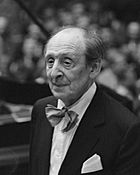

- Mikhail Bulgakov (1891–1940), Soviet writer and playwright.
- Vladimir Horowitz (1903–1989), American classical pianist.
- Milla Jovovich (born 1975), American actress.
- Kazimir Malevich (1879–1935), pioneer of abstract art.
Science and Technology
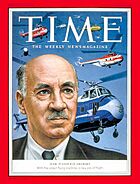
- Nikolai Amosov (1913–2002), Soviet and Ukrainian heart surgeon.
- Jan Koum (born 1976), American computer programmer, co-founder of WhatsApp.
- Borys Paton (1918–2020), scientist, chairman of the National Academy of Sciences of Ukraine.
- Igor Sikorsky (1889–1972), Russian-American aviation pioneer.
Politics

- Golda Meir (1898–1978), Israeli politician, the fourth Prime Minister of Israel.
Sports
- Oleg Blokhin (born 1952), Ukrainian football player.
- Valeriy Lobanovskyi (1939–2002), Soviet and Ukrainian football coach.
- Andriy Shevchenko (born 1976), Ukrainian footballer.
Other Notable People
- Oleg of Novgorod (circa 845–912), a prince who ruled from 882–912.
- Olga of Kiev (circa 900–969), a regent of Kievan Rus' for her son.
- Vladimir the Great (circa 958–1015), Grand Prince of Kiev and ruler of Kievan Rus'.
Honors
- Kyiv Peninsula in Graham Land, Antarctica, is named after the city of Kyiv.
Images for kids
-
Hungarians at Kyiv in 830 during the times of the Rus' Khaganate; painting by Pál Vágó.
-
Until 1936, Kyiv was a city on the west bank of the Dnieper.
See also
 In Spanish: Kiev para niños
In Spanish: Kiev para niños


